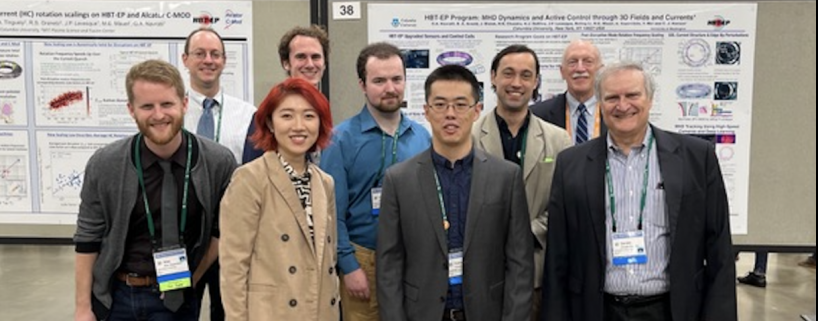Last week, Columbia University students, scientists, and faculty presented seventy-one research presentations at the 64th Annual Meeting of the APS Division of Plasma Physics held at Spokane, WA.

The APS-DPP Meeting is the world's largest research conference for plasma physics. This year, over 1,900 students and scientists attended in person for the week-long event. Highlights of the meeting were invited lectures presented to the participants of the DPP Meeting and to several linked conferences addressing timely and important special topics.
Alex Saperstein (doctoral student AP) presented his invited lecture, titled "Rotation of non-axisymmetric halo current in disrupting plasmas.” Alex combined observations from Columbia University's HBT-EP tokamak with observations from MIT's CMOD tokamak and presented a new drift-frequency-based scaling law for the rotation frequency of harmful asymmetric halo currents. Understanding the new scaling is important to efforts to prevent these halo currents in next step fusion energy devices, like ITER and SPARC.
Yumou "William" Wei (doctoral student AP) was invited to present his research at the 26th Workshop on MHD Stability Control. This workshop, organized by Dr. Jeff Levesque (Applied Physics PhD 2012), presented the latest developments in MHD control needs for burning plasma devices. William explained how deep-learning and neural net computing can be used for MHD mode tracking using high speed cameras. Dr. Ryan Sweeney (Applied Physics PhD 2017) was invited to present the "SPARC MHD Stability and the Error Field Strategy” developed for the upcoming burning plasma experiments at Commonwealth Fusion Systems (CFS) and MIT. Next, at the mini-conference on "Public-Private Partnerships for Fusion Energy" Dr. Brian Grierson (Applied Physics PhD 2009) ad Dr. Ben Levitt (Applied Physics PhD 2004) presented corporate plans for fusion energy R&D from General Atomics and from Zap Energy.
Many graduate students and scientists presented their research in "poster sessions." The largest poster session from Columbia University presented research and analysis from the HBT-EP experiment. (See photo.) Other notable presentations from Columbia University graduate students included Jalal Butt, Abdullah Hyder, William Boyes, Alexander Battey, Matthew Pharr, Haley Wilson, Anson Braun, Hari Choudhury, Priyansh Lunia, Daniel Burgess, Navin Sridhar (Dept of Astronomy), Jorge Cortes (Dept of Astronomy), Aaron Tran (Dept of Astronomy), from Columbia University scientists Steven Sabbagh (Applied Physics PhD 1990), Jeremy Hanson (Applied Physics PhD 2009), Ian Stewart (Applied Physics PhD 2020), Garima Joshi (Dept of Astronomy), Luca Comisso (Dept of Astronomy), and Columbia University faculty James Anderson (Electrical Engineering), Mike Mauel (Applied Physics), Gerald Navratil (Applied Physics), Lorenzo Sironi (Astronomy), Carlos Paz-Soldan (Applied Physics), and Elizabeth Paul (Applied Physics).
As is now tradition, today's students of plasma physics and fusion science are joined by alumni and collaborators for the annual Columbia University Plasma Lab Reunion Dinner. More than forty students and alumni gathered to celebrate the Lab's past and present research accomplishments. This year's Plasma Lab Reunion Dinner was organized by Dr. Ken Hammond (Applied Physics PhD 2017).